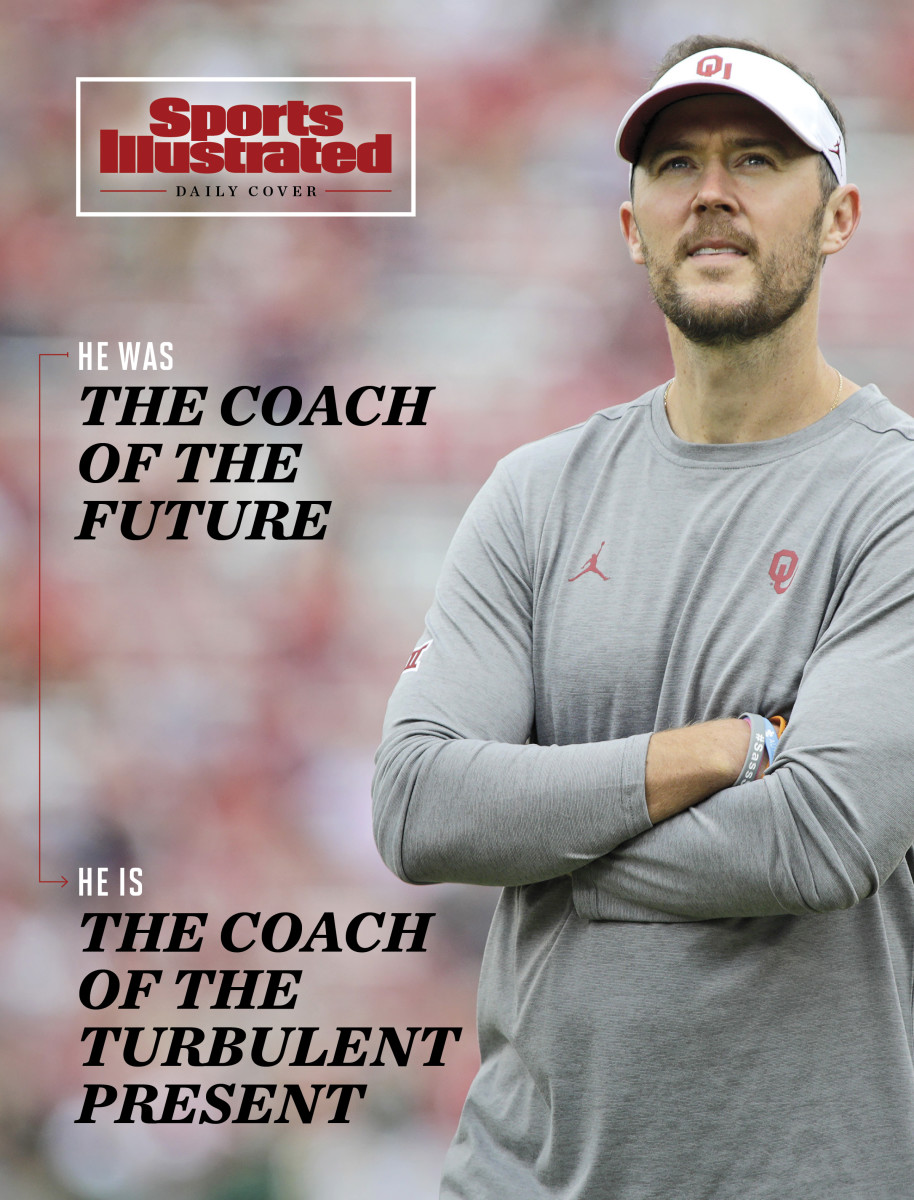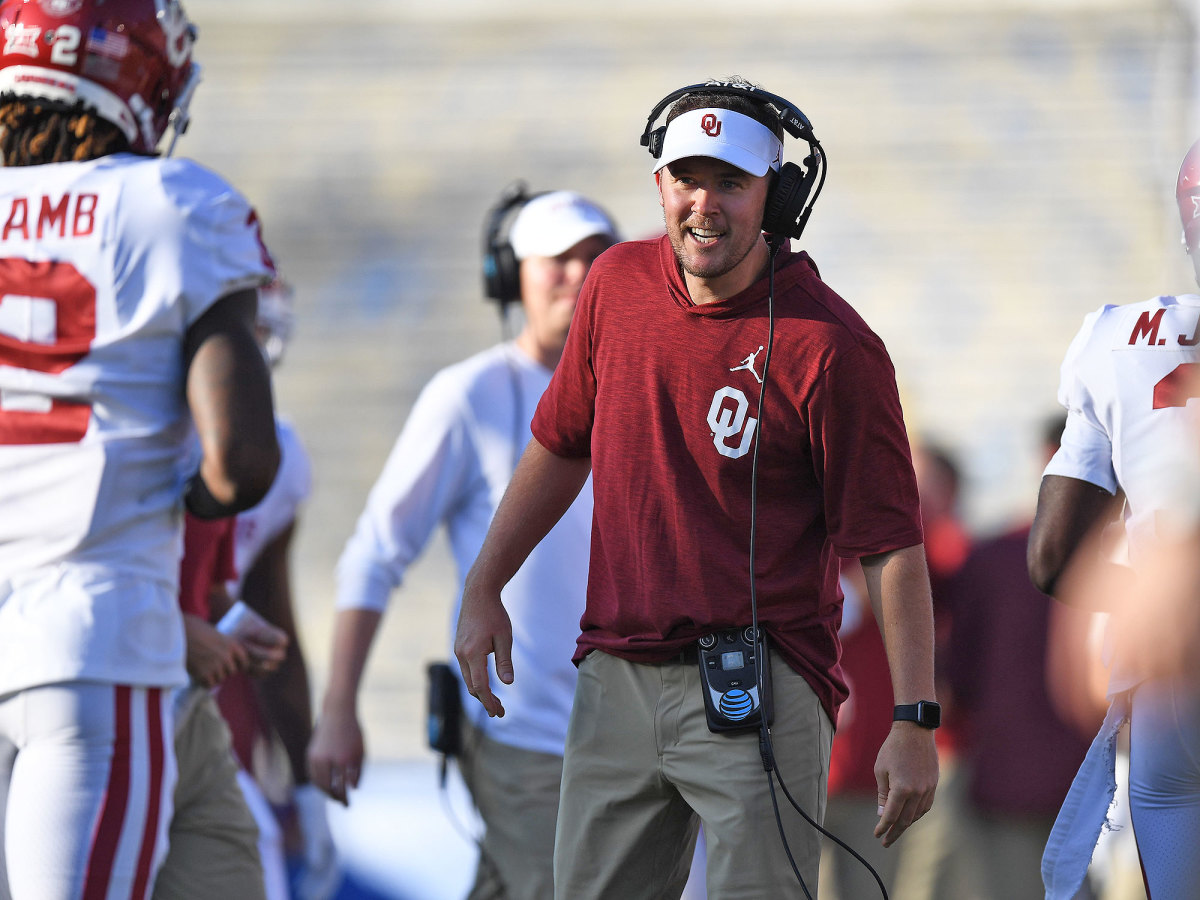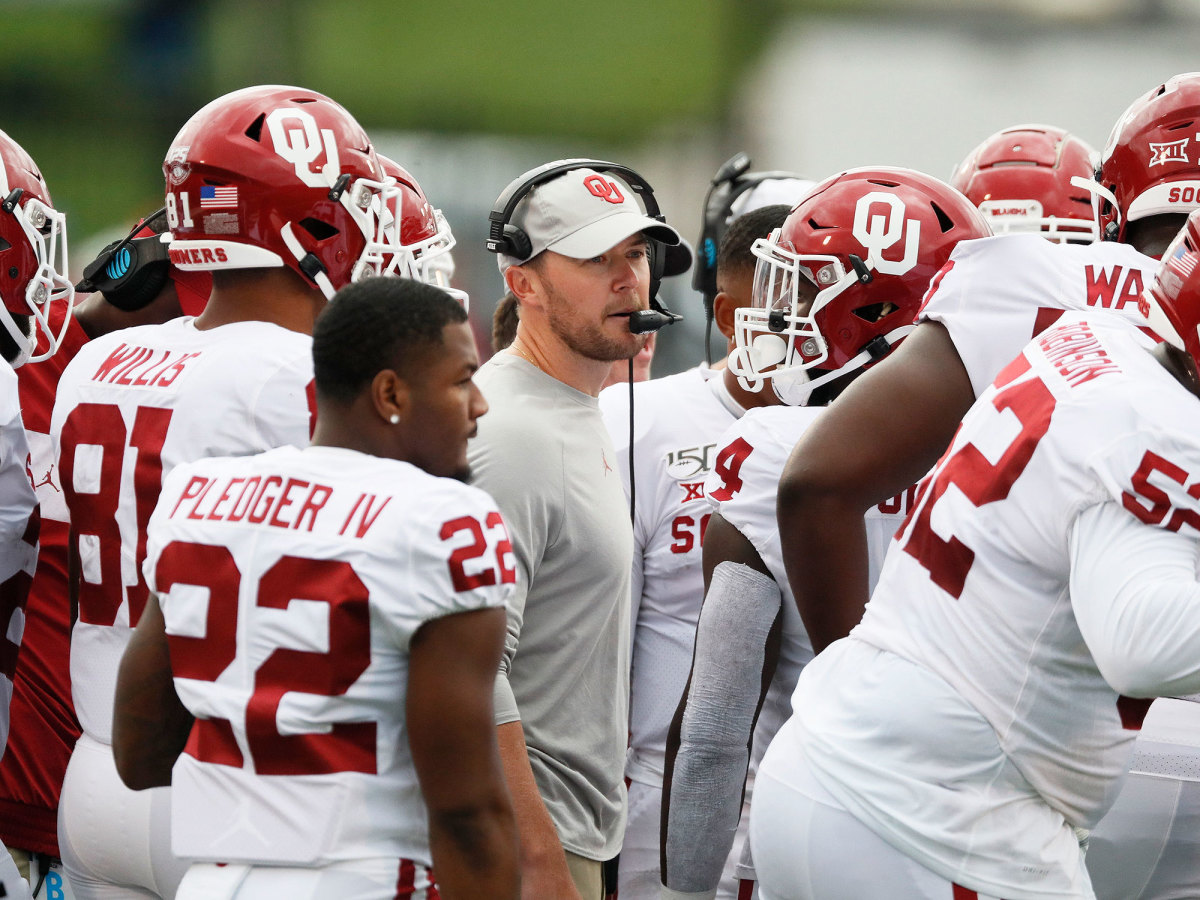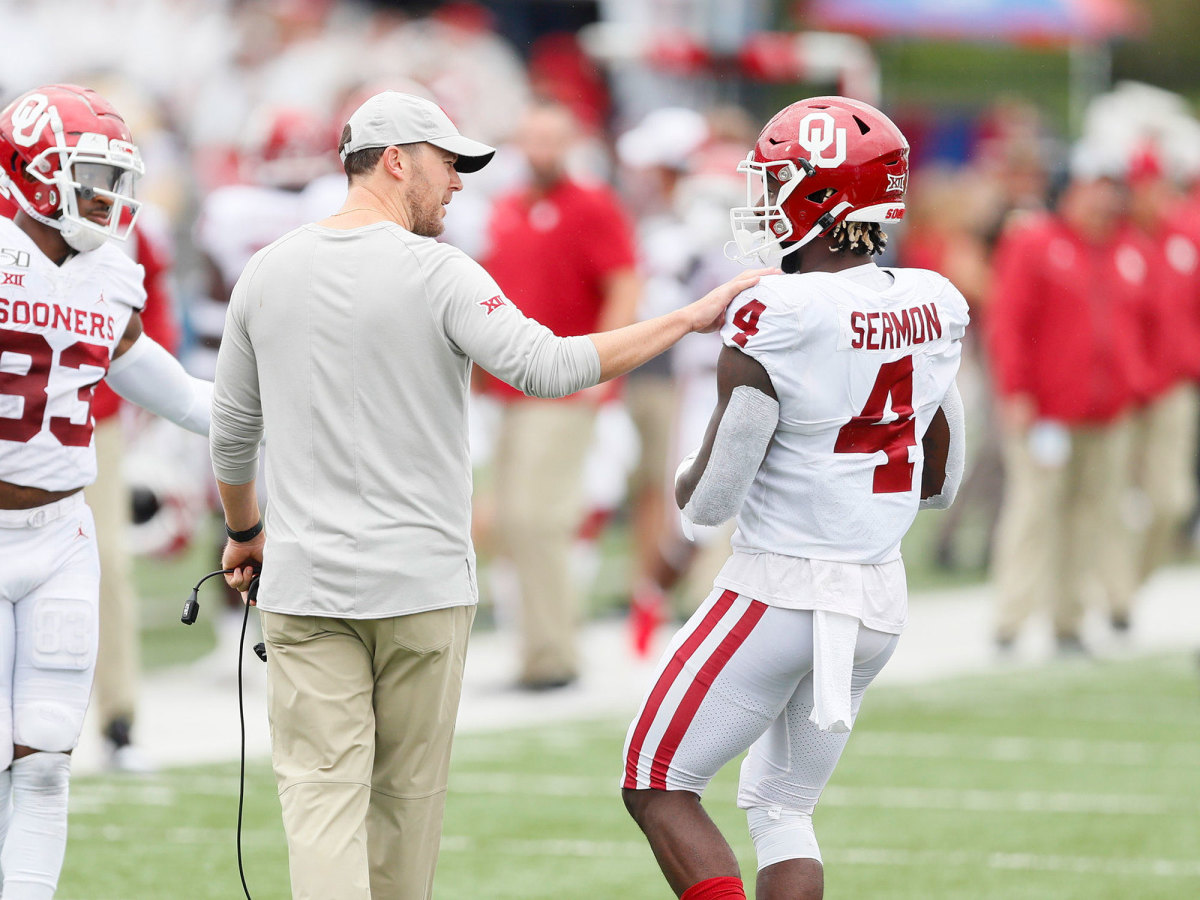Built for This: Why Oklahoma's Lincoln Riley Could Be the Ideal Coach in a Year Like 2020
This summer was supposed to mark the shift from legitimacy to supremacy, for both the precocious 36-year-old coach at Oklahoma and the merry band of coaching renegades who taught him to challenge every long-held convention in college football. Lincoln Riley had already obliterated the notion that the Air Raid coaching tree belonged on the fringe of the forest. He had mentored three Heisman finalists and made three College Football Playoff appearances in just three seasons as the head coach at OU. And, like all bright, innovative and adaptive young masterminds, he had become another Coach of the Future, the moniker hanging like a giant blinking neon sign above his head.
“Just wait ‘til we get good,” his coaches had told recruits all spring. They meant that despite five straight Big 12 titles, despite the Baker Mayfields and Kyler Murrays and CeeDee Lambs, Riley still considered his program as less than he envisioned, elite in spots but not all over, not like Clemson or Alabama—yet. LSU had highlighted that talent gap in the national semifinals, bludgeoning Oklahoma, 63–28.

Riley moved on quickly, believing his ’19 team had maximized its potential, despite suffering numerous injuries. He expected this group to contend for the Sooners' first national championship in 20 seasons, nothing less. When the Dallas Cowboys inquired about his interest, he never wavered in his commitment to OU. He read books about Bill Walsh and the West Coast Offense, hoping to incorporate some concepts but also wanting to learn more about how to sustain success. “I was really interested in how he was able to maintain that,” Riley says. “The guys I study have been guys who have been able to take winning teams, championship teams, whatever, and continue to build—no matter what happens.”
That last phrase—no matter what happens—would be tested in the bizarre alternate universe that is 2020, a year that increasingly became less about how Riley might change his world and more about how the world around him changed. As he conducted an interview in late June, he didn’t know if the season would start on time, or be played in the fall at all. His players had not yet arrived back on campus, due to concerns over the COVID-19, the global pandemic that had shut down sports in March. Many Sooners were immersed in Black Lives Matter demonstrations. More college athletes were starting to publicly denounce the hypocrisy behind the unpaid labor force and foolish notions of amateurism that built college football into a behemoth. They wanted to be compensated. More than that, they wanted to be heard.
On the surface, Riley and all college football coaches have entered a period of extreme turbulence, for obvious reasons (virus, protests, uncertainty) and less-obvious, more-team-specific ones. For Riley, who would replace Jalen Hurts at quarterback? Could the Sooners’ torched-by-LSU-defense continue to improve? But rather than hinder Riley’s rocket-launch progress toward the top of college football, perhaps his unusual path and atypical schooling have instead prepared him for the unprecedented nature of 2020 more than other coaches.
If that proves true, then this summer will mark when the Coach of the Future became the Coach of the (Turbulent) Present. Everything that made Riley one makes him the other, too. His most prominent in-state rival, Oklahoma State’s Mike Gundy, can embody the outdated thinking of many other college football czars. He can fumble his way through the virus response, demand his team return to campus; then don a T-shirt for a far-right news network; then admit he needed to work harder at building relationships after players threatened to walk. Riley, meanwhile, is attuned to the current zeitgeist of the nation, particularly as it affects his young and largely Black team.
All of which leads to a central question for this college football season, should there be a college football season. Is the renegade who vaulted an offense of outsiders into the mainstream just different enough to turn uncertain times into a competitive advantage? “I hope so,” Riley says.
****

The COVID-19 restrictions kept Riley in quarantine through the spring and summer, either at home, or in his penthouse-like on-campus office, where he handles all responsibilities—including interviews—via computer. His Zoom screen shows a chapel-like window over his right shoulder and an image of the famous Boomer Theater sign to his left. In between, there are shelves lined with celebratory footballs, family photos and an ornate light fixture that hangs from the ceiling. The display oozes serenity, in contrast to the world outside, which is raging, with the pandemic, unemployment, a recession and a national reckoning on race.
As the world descended into chaos, Riley told his assistants not to make excuses, to find opportunity in the tumult. He asked his players, “What can I do better for you?” He had always told both groups to look at each season like a puzzle, to find creative solutions. “It’s still a puzzle,” he says. “Same philosophy. Why change now?”
Riley spends every working hour in front of one screen or another. There are virtual staff meetings, videoconference recruiting visits, film review sessions. The landscape changes constantly, too. The coach reminds his athletic director, Joe Castiglione, of Tom Cruise’s character in the movie Top Gun, specifically that scene in the cockpit of a fighter jet, where Cruise locks on his target, preparing to fire, only for the target to continually move. “We’re all trying to figure out where the targets are,” Castiglione says. “But this backdrop will show who Lincoln is. He understands his surroundings as well as anybody I have seen.”
Riley had been trained to adapt, always, to upend conventions with fixes that might be considered wacky. He had grown up in the small West Texas town of Muleshoe, met his future wife, Caitlin, and took her to watch the movie Sweet Home Alabama and dine on unlimited breadsticks at the Olive Garden on their first date. His life trajectory was mapped out. He would coach football at a local high school, and she would be the cheerleading coordinator.
Then he met crazy ass Mike Leach. Riley went to Texas Tech to play for one of coaching’s most colorful characters, the Air Raid deity whose teams threw for country miles and broke scoreboards unable to process the number of points scored. For his first position meeting, Riley took out a notepad, wanting to appear diligent, only to watch Leach sandwich a plug of chewing tobacco under his lip, then wax for 90 minutes about dip, where it’s made, the different cuts and flavors. He never mentioned football once.
The next season, Leach floated a radical idea, marking Riley’s most prominent early lesson in adaptation. Riley was 19 years old, still in college, not legally old enough to drink. And Leach wanted him to … coach?
His trajectory changed in that instant. Riley traded the downtown college restaurants he once frequented for the spots favored by assistants who were in some instances old enough to be his grandfather. He cut off all of his college friends except for Caitlin. He never went to another frat party. “That was that,” Caitlin says. “All my college friends were dating football players, and I was dating an assistant coach.”
The most important lessons Leach imparted were less about any one play or even one particular approach. Instead, Leach taught Riley how to think. He told Riley to challenge him in meetings; to give little thought to losing jobs, or games; to dismiss how football had been played for decades, winning instead by cultivating an outlaw spirit that encouraged innovation (and waves of college football games decided by who could score 50, 60, or 70 points).
The man often tabbed as the Air Raid inventor, Hal Mumme, says he always intended for the system to be “more philosophy than a playbook.” In fact, he snorts that in all his decades of coaching everywhere from UTEP to Iowa Wesleyan to the XFL, he never really even had a playbook. He borrowed vertical pass concepts from BYU and West Coast crossing routes from the 49ers. But he fashioned his offense around his best players. He never understood why so many coaches resisted change. He didn’t draw up a million plays. He favored quick reads and easy throws and decisions made before the ball was snapped.
Eventually, Riley did graduate and become the wide receivers coach. In 2009, he even called plays for the Red Raiders in the Cotton Bowl, where they fell to Ole Miss but scored 34 points. The security guard posted by the locker room refused to allow Riley back inside, figuring him for a young fan. “Dude, what are you doing?” wideout Michael Crabtree told him. “This is our OC.” Riley smiled his way inside.
“Even then,” Crabtree says, “you saw how Lincoln could adapt.” To the life of an assistant coach. To his status as a boy genius OC. And, of course, to the instability of 2020.
****

Where other major college programs asked uneasy players to return to campus as soon as state law allowed this summer, Oklahoma told its players not to report in June. Informal workouts for those other teams had led to spikes in coronavirus cases, and Riley wanted to take a more typically analytical approach. After canvassing scientific experts and reading summaries of studies, he didn’t want to assume additional, unnecessary risk. He saw even the time his players spent away from the facility as a potential advantage; every day he didn’t rush them back, his medical staff could learn more about how to protect them, while health companies developed vaccines and tests and better PPE.
What’s important, junior safety Pat Fields says, is not just that Riley took something every coach says—I care about my players—and applied his core challenge-everything philosophy to an uncertain time. It’s that Riley already lived that way. “You’ve seen a lot of other universities rush people back, and it has blown up on them,” Fields says. “Coach Riley took a different approach from everybody else in the country, especially for schools in the Power 5.”
Honing that process had continued after he left Tech, when Riley experimented with how he wanted to reach players, borrowing from the Air Raid but drawing up new schemes. He became the offensive coordinator at East Carolina in 2010, at 26, then banked the top five offensive campaigns in school history. His savant-like success spoke to how his brain worked.
“You’ve seen a lot of other universities rush people back, and it has blown up on them. Coach Riley took a different approach." —OU safety Pat Fields
Assistants describe Riley as cerebral and intellectual and brilliant, like he’s a mathematician who fell into coaching. Riley will allow that his memory is “decent” as it relates to football, admitting that he can remember sequences of games from high school. On his weekly radio show, they diminish that humility, naming a play each week from his distant past. Riley always remembers the point in the game, the down and distance, the strategy the defense countered with and the result. People that really know him, like his wife and most trusted confidants, use another word to describe his football memory. “Photographic,” Mayfield says.
“That’s not just a rumor,” says Alex Grinch, his defensive coordinator.
Still, anyone who views Riley as strictly a beautiful-mind-numbers-crunching nerd misses the intuitive feel he again showcased this offseason. His wife says that people as math-brained as her husband can often seem detached or quirky. But Riley is not a cookie cutter robot coach.
In fact, he’s the rare offensive specialist who says he doesn’t grade his quarterbacks. He learned that it’s better to trust what he can see during one season at East Carolina, when he graded two players of similar ability, then chose the starter based on the highest score. “When I did it,” he says, “my instinct was telling me, it’s the other guy, don’t listen to the math.” His instinct was right. Riley switched to the backup in the middle of their second game and never went back. “I don’t give a damn about some 98 or 87%,” he says. “If I don’t have enough feel about how they should play, then I shouldn’t be coaching the position anyway, honestly. It’s certainly more feel than numbers, for sure. More art than math, in a way.”
Riley learned to become comfortable in making decisions that weren’t typical, weren’t safe. As he ascended from good jobs into better ones, he watched as former Tech colleagues struggled to land head gigs. Perhaps they were too quirky, too different, too much like Leach, who hung a painting of himself as a centaur in his office, nearby a stuffed pirate. Maybe athletic directors didn’t want to turn to renegades to reinvent their programs. Riley says the band of Air Raiders spoke openly but privately about their frustration. They’d laugh about leading the nation in offense and not getting jobs. “You could feel the whole thing getting ready to blow up,” he says. “It was almost like it was so new and off-the-wall that people were afraid of it.”
Slowly, that resistance started to break down. Dana Holgorsen took over at West Virginia in 2011. Sonny Dykes became the head coach at Cal in ‘13. And Bob Stoops, the Oklahoma coach who had won a national title with Leach as his offensive coordinator, had started to wonder by ’14 whether his system needed an upgrade. At the annual coaching camp he ran with Mumme in the offseason, he turned to the godfather and asked, “How come everybody in our conference can run our offense better than we run our offense?” Mumme recommended two former Tech assistants for an overhaul: Sonny Cumbie and Lincoln Riley.
Stoops’s quarterback, Mayfield, already knew Riley, having been offered a scholarship to ECU that he turned down. The QB found the math-feel duality that Riley exhibited “extremely rare” and the “perfect hybrid for this day and age.” Riley, Mayfield says, has demonstrated that he can relate to his players “better than almost anybody.”
His coach hired Riley in 2015, firing two successful offensive coordinators who would become head coaches in favor of the relative unknown from ECU. The Air Raid influence, the comfort in making an unpopular decision, had been ingrained in Stoops, too.
****

The Coach of the (Turbulent) Present turned his virtual offseason into a series of team development exercises, which took place three times each week. He showed clips of the Michael Jordan documentary The Last Dance and spent one day detailing the maniacal competitive pursuits of the late Kobe Bryant. Riley also had former players hop on Zoom and tell their younger counterparts about race relations, social justice and the real-world issues they would have to confront after football.
The coach did not ignore Black Lives Matter, or, worse, espouse ignorant notions like racism doesn’t exist in college football or America. He let his counterparts make unforced errors. He posted BLM on his Instagram page, said BLM in news conferences and told his players he not only would attend a demonstration but that he would also speak at it, which he did. “You don’t see too many coaches in college football doing that,” Fields says. “It’s hard right now, to be a Black man in America, seeing everything that’s going on. At points, you feel like giving up. But when Coach Riley has our back, it makes me want to feel hopeful.”
When Fields worked out with players from other schools this spring, they expressed envy at the culture that Riley built. Not just that Riley seemed to hear his players, but that he believed in what they believed in, so much so that even in a conservative state like Oklahoma he did what he felt was right, not what he felt he needed to do for optics. “I hope our guys know who we are and would have expected that out of us before any of this,” he says. “I hope it’s not surprising for them.”
In the two seasons that Riley apprenticed under Stoops, he saw how Stoops handled his myriad responsibilities, how he served as coach, psychologist, mentor and program CEO. In 2015, Riley watched Stoops navigate a racist incident at OU, where members of the Sigma Alpha Epsilon fraternity were shown in videos chanting racist slurs. (Two were eventually expelled.) Stoops’s players planned a walkout one day in response—and Stoops supported them. He told his assistants, “We’re not practicing for a good while. Let them express themselves, listen to them, be there for them—however long it takes.” The players returned to practice when they were ready, and they were more loyal to their coach, because he had been loyal to both them and his principles. That’s how Stoops won 190 games, Riley thought.
He didn’t yet know what Stoops had told his wife on the eve of the regular-season finale the next season, before the Sooners played Oklahoma State. Not only was he thinking of retiring, but he had also tabbed his successor. He wasn’t sure if he would step away, but if that marked his final game at OU, he wanted her to know. “Lincoln was part of the reason I had thoughts of, hey, this might be a perfect opportunity,” Stoops says now. “I knew I wouldn’t be leaving the program in a lurch.”
By then, Riley’s offensive system hardly resembled what Leach taught him. With better offensive linemen, he ran the ball more—and more effectively—and he dramatically changed his scheme each season, even after Stoops abruptly stepped down before the start of ’17. Riley would meet with Stoops for four hourlong advice sessions, asking everything from if he should continue to call plays to how he might handle outside turmoil. Stoops told Riley to continue to run the offense, if he wanted to, but to take a more holistic overall approach. Eventually, he called Riley—from a golf course down in Florida, where he passed the phone to a friend. “I don’t care what they say,” Steve Spurrier told Riley. “Keep doing what you’re doing.”
At 33, Riley had become the youngest head coach of a major program in the country. He celebrated by staying up until 1 a.m. to send missives to recruits, spending one hour to recap with his family, catching a nap and reporting to the weight room at 6 a.m. There, he delivered a simple message to his players, the same one that would resonate in 2020. The significant part, says former star linebacker Kenneth Murray, was: I’ve got your back.
****

Everything from Riley’s past—his willingness to adapt, to challenge norms, to make decisions that would be criticized, to support his players, to do what’s right—informed how he operated as a head coach. Even then, he continued to change a program that already enjoyed sustained success. He bolstered recruiting efforts—brand logos for each signee, video shoots in Los Angeles and Dallas—upgraded the facilities, revamped the strength-and-conditioning program, bolstered the university’s mental health efforts and changed his offense every year to reach the playoff. “He made the next step of the evolution of our program,” Stoops says. “It’s also fair to say he elevated it.”
When the world changed this spring as Riley looked toward his most promising season yet, he adapted again, too, in the face of a global pandemic and falling statues, still innovating, only now off the field as much as on it. He still ate Olive Garden, except not inside, given the crowds that formed. Different puzzle, same approach. “That’s going to help him win this season,” Mayfield says. “Just the way his mind works, the way he takes input and applies it, consulting everyone around him.”
“Him winning [at Oklahoma] was big for us. If the system is a gimmick, it’s one that every coach in college football looks at now.” —USC OC Graham Harrell
Thus two arcs continued—the evolution of the Air Raid and the wunderkind. To win like that, at Oklahoma, at the highest levels of college football, had stamped the system as more than the off-the-wall uncle alternative to more traditional systems. Riley proved he could retain the ethos without Leach’s tangents on dip, Mumme’s itinerant path or the tired notion that Air Raid coaches only throw deep passes and ignore half of football. Riley is a renegade who can pass for normal, who is normal, in so much as any football coach can be. “For a long time, people thought this was a system for underdogs who weren’t mainstream,” says Graham Harrell, the offensive coordinator at USC who learned the system from Riley as a player at Texas Tech. “Him winning there was big for us. If the system is a gimmick, it’s one that every coach in college football looks at now.”
When Fields, the safety, looks at other programs, he sees a disconnect between the players and their coaches/administration. In most places, it’s only growing more pronounced. But not with Riley. Not at Oklahoma. Maybe that’s why the coach continues to swat away NFL overtures, because he can relate to younger players, because he can really hear them. “We’re watching a coach with extraordinary intellect develop before our eyes,” says Castiglione, the AD. “That’s an extraordinary experience to behold …” He catches himself, as if not wanting to jump too far into an uncertain future.
The question that hovers over 2020 is whether Riley’s unusual path and evolving philosophy will lead back to the same championship an original Air Raider in Leach helped bring to Oklahoma two decades ago. There’s change all around Riley—in the world, on his team, with how outsiders view his mentors and career trajectory. But Riley will not change the spirit that now defines him. If anything, if there is a college football season, it will make him more dangerous, more malleable and better positioned to return the Sooners to national championship glory and solidify the Air Raid as a mainstream approach. Then the Coach of the (Turbulent) Present will complete the circle, becoming the Coach of the Future again, too.
Read more of SI's Daily Covers stories here
More Oklahoma Coverage From SI.com:
Sooners' First Football Practice Is 'A Long Time Coming'
A Closer Look at Lincoln Riley's New Oklahoma Contract
With Caleb Williams, Lincoln Riley's Plan Is Unfolding Perfectly
